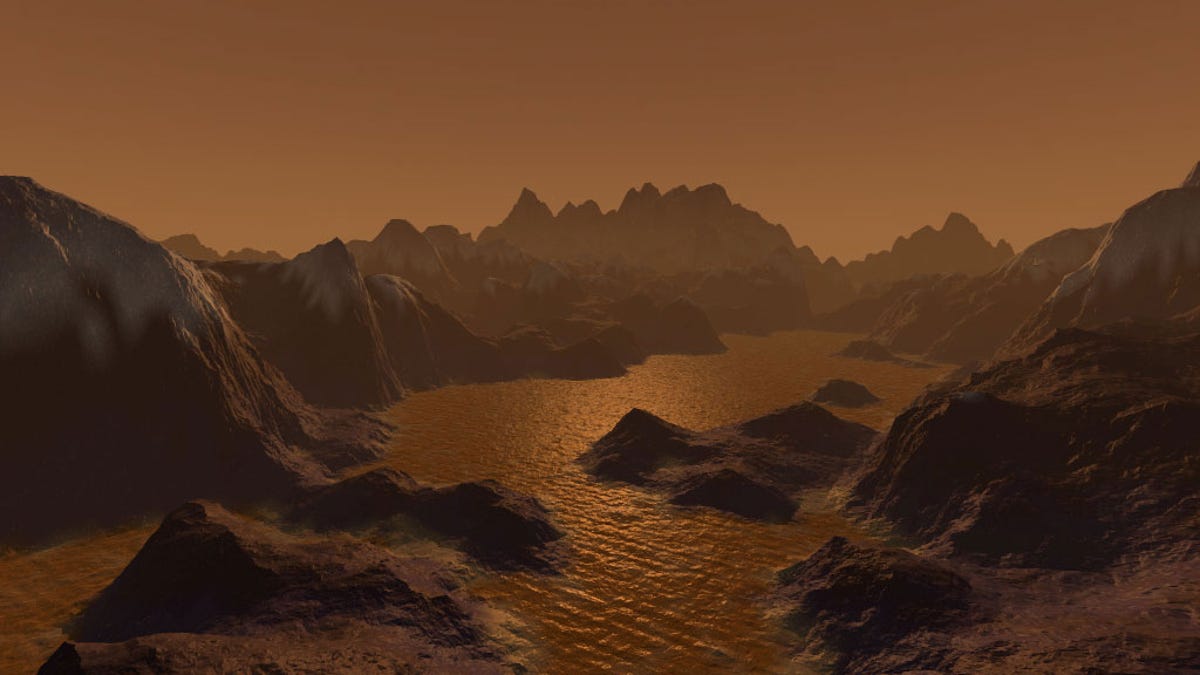Scuba diving trumps surfing on Saturn's Titan moon
Headlines described the sighting of waves on Titan this week, but it's really still smooth sailing on the impressively deep lakes of the Earth-ish moon.

There was a lot of hubbub this week among space geeks about the first spotting of waves on the freaky methane lakes that cover much of Titan, perhaps the most Earth-like spot outside of the real deal in our solar system. But it's still waaay premature to pack up your space wetsuit and start nagging NASA or Elon Musk to hitch a ride beyond the asteroid belt.
Saturn's spooky moon has a planet-like atmosphere and liquid covering much of its surface, making it one of the most likely nearby places to harbor (probably very weird) alien life. But while Titan shares a number of Earth-like characteristics such as its craggy peaks, running rivers, and even thunderstorms, it doesn't appear to have strong enough winds to whip up methane waves on its large lakes.
At least, we haven't been able to see them during the time we've been looking closer with the Cassini spacecraft, which has been cruising around above Saturn and Titan for years now. But as we learned last year, things could be shifting on Titan as the longer seasonal cycle on the moon is finally bringing summer to its lake-filled northern half for the first time since we've been watching closely.
Some astronomers think winds and surf season could be in full effect by 2017, so there was plenty of excitement earlier this week at the Lunar and Planetary Science Conference outside of Dallas where researchers discussed measurements of Titan's surface that seem to hint at the presence of waves, according to Nature.
At least that's the way the headlines put it this week.
Read further on, however, and the story is that the images taken by Cassini between 2012 and 2013 showed something abnormal on the surface of Punga Mare that could be waves or more accurately, ripples, given that the disturbances were calculated to be no more than a few centimeters high.
"Titan may be beginning to stir," Ralph Lorenz, a planetary scientist at the Johns Hopkins University Applied Physics Laboratory, told the conference. "Oceanography is no longer just an Earth science."
If the stirrings continue to increase, we could get to witness some very interesting activity on Titan, hopefully before Cassini is scheduled to hurl itself into Saturn's atmosphere in 2017.
In the meantime, however, Titan still has the smoothest sailing in the solar system. The latest radar measurements, published earlier this month online in Geophysical Research Letters, find that Titan's second-largest lake, Ligeia Mare, "possesses a mirror-like smoothness."
"If you could look out on this sea, it would be really still. It would just be a totally glassy surface," Howard Zebker, professor of geophysics and electrical engineering at Stanford, said in a release.
Zebker also suggests that the lack of motion in Titan's ocean could be due to something else, like a more viscous topping on the lake surface.
"For example, on Earth, if you put oil on top of a sea, you suppress a lot of small waves," he said.
His team's research also determined the depth of Ligeia Mare, which it found to be nearly 500 feet deep in at least one spot.
So maybe it makes more sense to plan a scuba diving vacation on Titan than a surfing excursion. Either way, you can get a feel for the exotic locale in this modeled fly-over:

